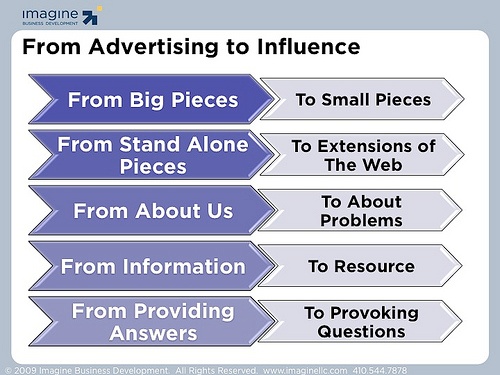As more and more data supports the diminishing return of traditional advertising, businesses (especially small and mid-size B2B businesses) are left wondering what to do. I've written many times this year about the importance of a content development strategy, and how do utilize content to support the sales process.
I'm in the middle of conducting a full review of how one of our clients is approaching this issue (a process we call The Packaging Audit). The vast majority of their promotional efforts are focused on traditional advertising in the form of direct mail, trade magazines and trade shows. The fundamental problem with this approach is that it creates no equity value whatsoever. In order to continue getting results (and diminishing ones at that) one must continue to do at least what they did before.
We agreed that we wanted to cut by at least 50% their expenditure on their legacy approach, and begin building promotional efforts that built equity value (meaning they increase in the value and impact without increasing effort or costs). Additionally, we agreed that any new budget items would have to clearly support The New Marketing Funnel. While they've certainly cut (especially on tradeshows), their concern was how would they continue to drive results if they cut across the board - even though they were not convinced there was any real ROI on these activities (a very common SME issue).
The value of a content strategy is that it focuses on creating value - rather than interupting the customer. If one takes the same approach to their advertising - looking to go beyond advertising and promotion to real influence - then the results can be equally compelling. Making this transformation, however, means that you must completely rethink all (and I mean ALL) of your advertising and corporate colatoral. This includes (but is not limited to) your website, your ads, your brochures, your product data sheets, your sales tools, etc. Here are the five key points to making this transformation:

Do your own audit - take a look at every piece of sales, advertising or promotional communication and ask yourself if you are applying these five points.

 Doug Davidoff
Doug Davidoff